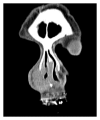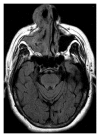Delayed diagnosis of nasal natural killer/t-cell lymphoma
- PMID: 24396622
- PMCID: PMC3874948
- DOI: 10.1155/2013/918132
Delayed diagnosis of nasal natural killer/t-cell lymphoma
Abstract
Midline destructive lesions of the face have multiple possible etiologies. The majority of these cases are found to be due to an extranodal lymphoma of natural killer/T-cell-type non-Hodgkins lymphoma (NKTL). Unfortunately, diagnosis is often delayed. With variable presenting complaints, including nonspecific issues like chronic rhinosinusitis or nasal congestion, initial treatments are aimed at these presumed diagnoses. Only as the lesion progresses do overt signs of destruction occur. As with our patient, who was initially treated for presumed infection and abscess, final diagnosis often does not occur until several months, and several antibiotic courses, from initial presentation. As such, it is important for this rare entity to remain in the clinician's differential diagnosis for nasal lesion.
Figures




References
-
- Paik YS, Liess BD, Scheidt TD, Ingram EA, Zitsch RP., III Extranodal nasal-type natural killer/T-cell lymphoma masquerading as recalcitrant sinusitis. Head and Neck. 2010;32(2):268–273. - PubMed
-
- Sharma A, Dandekar M, Deshmukh S, Dabholkar J. Nasal extranodal natural killer T cell lymphoma: an atypical presentation. Journal of Laryngology and Otology. 2011;125(11):1181–1184. - PubMed
-
- Parker NP, Pearlman AN, Conley DB, Kern RC, Chandra RK. The dilemma of midline destructive lesions: a case series and diagnostic review. American Journal of Otolaryngology. 2010;31(2):104–109. - PubMed
-
- Lee J, Cho S-G, Chung S-M, et al. Retrospective analysis of treatment outcomes for extranodal NK/T-cell lymphoma (ENKL), nasal type, stage I-IIE: single institute experience of combined modality treatment for early localized nasal extranodal NK/T-cell lymphoma (ENKL) Annals of Hematology. 2013;92(3):333–343. - PubMed
-
- Turner JH, Loyo M, Lin SY. Aggressive sinonasal natural killer/T-cell lymphoma with hemophagocytic lymphohistiocytosis. American Journal of Otolaryngology. 2012;33(1):188–191. - PubMed
LinkOut - more resources
Full Text Sources
Other Literature Sources
Research Materials

